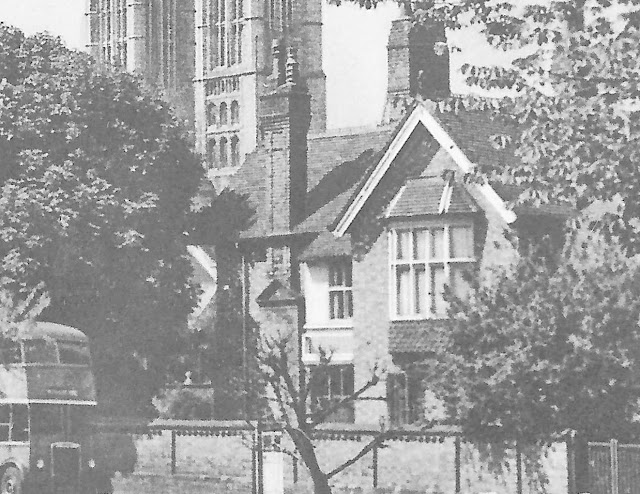
The need for a lunatic asylum in Lincoln had been discussed since the opening of the County Hospital, one of the main promoters of this was Dr Willis of Greatford, the man who treated George III for his madness. Money for the Asylum was raised through public subscription, some subscribers gave as much as £100 (Worth £9,728.58 today).
The Lincoln Lunatic Asylum is a Greek revival building designed by Richard Ingleman (1777-1838). Building commenced in 1819 and the Asylum opened for patients on 6th April 1820. It was Britain's first purpose-built Lunatic Asylum and became the first asylum in the country to achieve total abolition of mechanical restraint in 1837.
The buildings stand on grounds of 8 acres, west of Lincoln Castle, which was deliberately planted with trees to shield the patients from "poisonous miasmas" which came from the industrialised parts of Lincoln.
The Asylum, led by Dr Edward Parker Charlesworth (see below) pioneered new ways of treating mental illness, without the use of restraint and barbaric methods to control patients.
One of the early Medical Superindents was Robert Gardiner Hill, who was a leading doctor in the field of mental illness.
Following the opening of the County Lunatic Asylum at Bracebridge Heath in 1852, there was an increasing emphasis on fee-paying patients. The Asylum was re-named as The Lawn Hospital for the Insane in 1885.
New kitchens, waiting rooms and offices were built in 1893, designed by W Scorer of Lincoln.
Nurses Hostel was built in 1938 and is now the Charlotte House Hotel
The Hospital was taken over by the National Health Service in 1948 and was finally closed in 1985. The City of Lincoln Council purchased the Lawn in 1986 for £425,000, following extensive refurbishment the complex opened in 1990 as catering and events venue.
R W Stokes Ltd purchased the buildings only for £1,000,000 in 2015 for their headquarters and barista training.
Edward Parker Charlesworth
Edward Parker Charlesworth was born in 1783 in the village of Ossington, Nottinghamshire, the son of John Charlesworth, the local rector. After undergoing initial training at Horncastle under Dr E. Harrison, he studied at Edinburgh University where he graduated as a doctor of medicine in 1807.In 1805 he married Susannah Rockcliffe, daughter of Dr Rockcliffe of Horncastle.
Dr Charlesworth acquired a large practice in Lincoln and in 1808 he was appointed physician to Lincoln County Hospital, which was then on Michaelgate.
The Lincoln Lunatic Asylum – a private hospital for the mentally ill – Dr Charlesworth was appointed as visiting physician.
His methods were revolutionary – and unpopular – in his work to change the restraint methods employed by medical staff in the majority of mental hospitals. His efforts were soon recognised and an order banning hospital attendants from using restraint or violence was made.
In 1824 he became involved in an argument with Charles Sibthorp of Canwick Hall. Angry words were exchanged at a turnpike meeting which culminated in a duel being fought between the two men. The duel took place on 9th August 1824 in a secluded place between the Carholme and the Burton Plantation. Although shots were fired both men missed and honour was satisfied.
Dr Charlesworth died of paralysis on 21st February 1853 and was buried in St Margaret’s Churchyard, Lincoln.
A statue by Thomas Milnes (1813-1888) was erected in his honour in the grounds of The Lawn and unveiled on 12th July 1854
Robert Gardiner Hill
Robert Gardiner Hill was born in Louth, Lincolnshire in 1811 and was educated at Guy’s and St.Thomas’ Hospitals and qualified as a M.R.C.S. (Member of the Royal College of Surgeons) and a L.S.A. (Licentiate of the Society of Apothecaries) in 1834. In the same year he was appointed house surgeon to the General Dispensary at Lincoln, in 1835 he was elected Medical Superintendant at the Lincoln Lunatic Asylum."After he left Lincoln Asylum in 1841 Robert Gardiner Hill went into general practice in Lincoln with another doctor - Harvey - but after a few years started a private mental hospital in Lincoln (note: Eastgate House).
"Apparently he was extremely popular in the town for his good work and in 1851 they made him mayor ..... Robert Gardiner Hill then took a private home at Brentford but after two or three years bought Shillingthorpe Hall near Lincoln to do the same type of work on his own.
"He then went back to London and took over Earls Court House where he prospered and died." (Typed note in Dr Harold Gardiner-Hill's Family Book)
He married Charlotte Brown in Lincoln in 1841. He was Mayor of Lincoln in 1853.
His ‘non-restraint’ method, which was ‘a procedure with momentous results to the insane’, led to the widespread practice of this principle in England.
He died of a stroke at his home, Earls Court House, Old Brompton, London, in 1878.
Sources: Obituary: British Medical Journal










